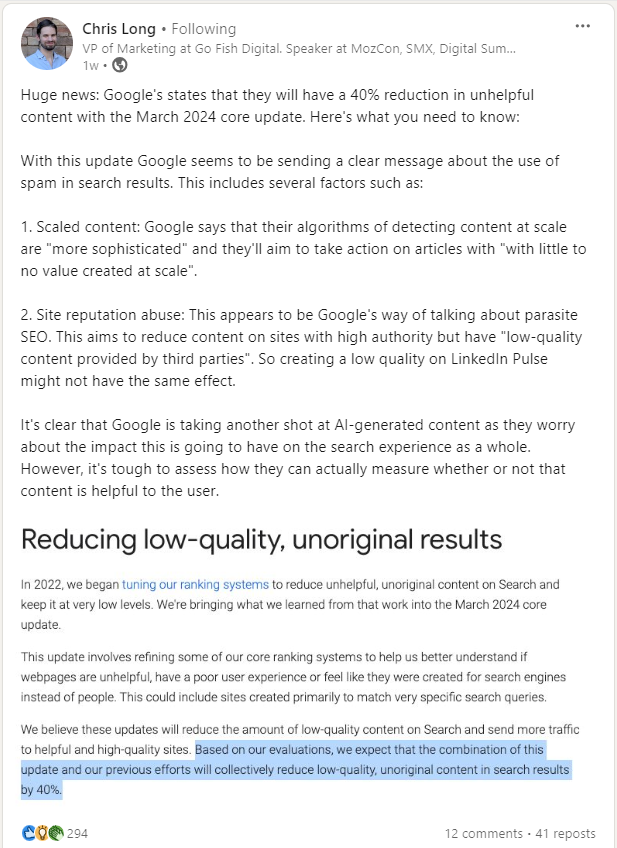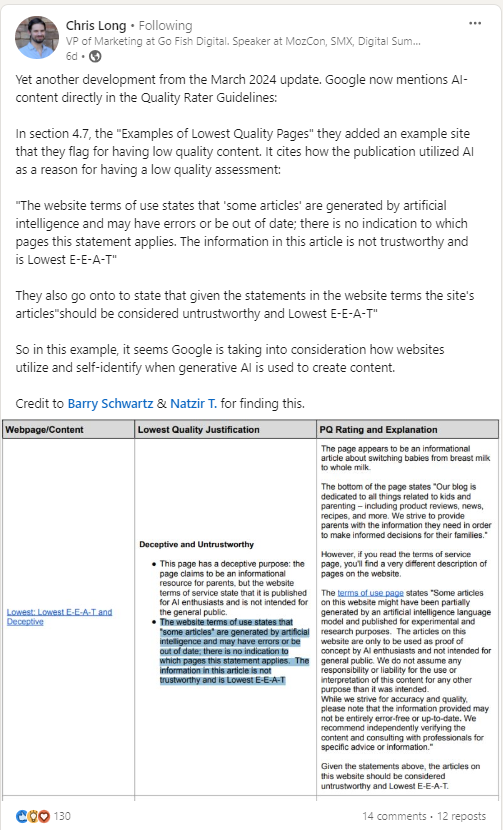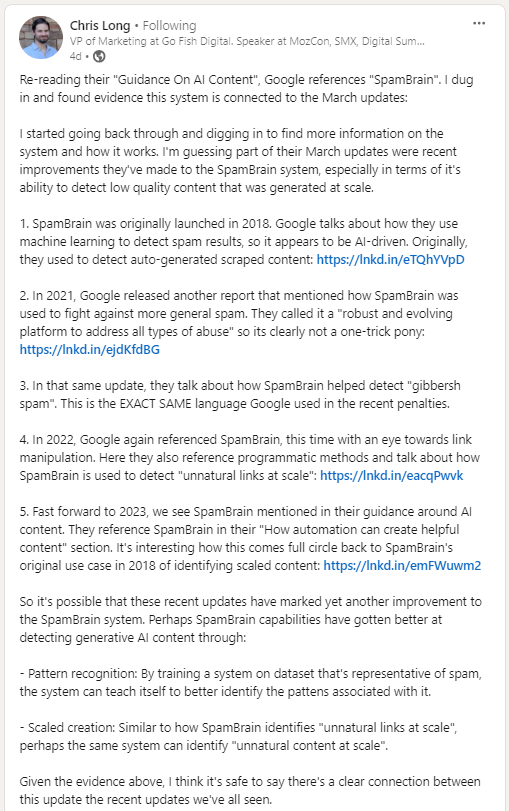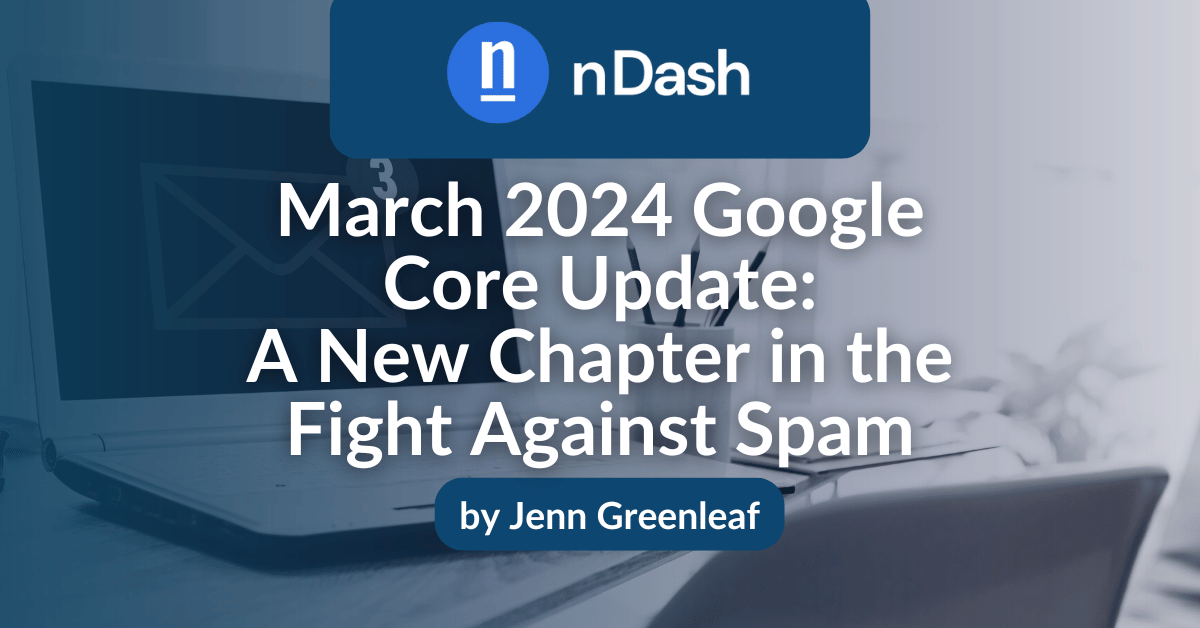Are you ready for the March 2024 Google Core Update? Before we get into that, let’s talk about why it matters.
We’ve all been there – finding reliable information online can be a struggle. You click on a stat in a current blog post that leads to another that links to something written ten years ago. Or, worse, the stat doesn’t exist at all.
But that’s just one example. What happens when you search for information about a specific problem and all you see are ads or misinformation? That’s frustrating – no one likes sifting through irrelevant sites to find one that actually has what they need.
Google’s March 2024 update tackles this head-on by cracking down on spam and low-quality content. This change promises a cleaner search experience with more trustworthy results. It also sends a strong message to content creators and SEO specialists, emphasizing the importance of high-quality content.
Understanding Google’s March 2024 Update
Chris Long, VP of Marketing at Go Fish Digital, highlights the impact of the March 2024 update, “Huge news: Google states that they will have a 40% reduction in unhelpful content with the March 2024 core update.” Google’s update focuses on targeting low-quality content and prioritizing user experience.

Here’s the TL;DR version:
Google’s March 2024 update is a combination of core algorithm changes and stricter spam policies. Here’s a breakdown of the key points:
- Targeting low-quality content: The goal is to significantly reduce unhelpful and unoriginal content in search results. That includes content created by AI, websites repurposed for spam, and pages with poor user experience.
- Deindexing websites: Google is completely removing low-quality websites from its search index, not just penalizing them in rankings.
- Focus on helpful content: The update prioritizes high-quality, human-generated content that provides value to users. Therefore, websites should focus on informative, well-written content that addresses user needs.
- Impact on SEOs: SEOs need to adapt their strategies to prioritize original content and user experience. Google is targeting tactics that focus on exploiting loopholes for removal.
👉 Note: The update is still rolling out, so experts recommend waiting for its completion before making SEO changes to your website.
💡 Action Item: Review your website content and identify any pages that might be considered low-quality by Google’s standards (thin content, automatically generated content, etc.).
The Fight Against Spam and Low-Quality Content
An analysis tracking the indexing status of over 49,000 websites post-update showed that 837 sites were completely removed from Google’s search index, constituting about 1.7% of the monitored sites. This action resulted in a substantial loss of over 20 million monthly organic visits and an estimated $446,552 in monthly advertising revenue for the affected sites.
Google prioritizes providing searchers with the most relevant and trustworthy information possible. To achieve this, they constantly battle spam and low-quality content through a multi-pronged approach.
In a separate LinkedIn post, Long explains, “Yet another development from the March 2024 update. Google now mentions AI content directly in the Quality Rater Guidelines:
In section 4.7, the ‘Examples of Lowest Quality Pages,’ they added an example site that they flagged for having low-quality content.”

Defining Spam and Low Quality
Google defines spam content as anything that attempts to manipulate search results or deceive users. That includes:
- Keyword stuffing: Filling a webpage with irrelevant keywords to rank higher in searches.
- Thin content: Pages with minimal or superficial information that doesn’t provide value to the user.
- Automatically generated content: This includes content created by bots or algorithms without human oversight, often nonsensical or irrelevant.
- Link schemes: Unnatural attempts to boost a website’s ranking by manipulating backlinks from other sites.
👉 Note: Understanding Google’s definitions here is crucial for content creators and SEOs alike. It sets the stage for developing strategies that align with Google’s quality expectations.
Low-quality content, while not necessarily manipulative, still detracts from the user experience. That includes:
- Unoriginal content: This involves content heavily copied from other sources without adding value.
- Clickbait: Headlines designed to entice clicks but don’t deliver the promised content.
- Pages with poor user experience: Websites with excessive ads, broken layouts, or mobile incompatibility.
💡 Action Item: Become familiar with Google’s definition of spam content and low-quality content.
Strategies to Combat Unwanted Content
Google uses a sophisticated combination of automated systems and human expertise to combat spam and low-quality content:
- Algorithmic updates: Google’s search algorithms identify and downrank websites that exhibit spammy characteristics.
- Manual reviews: Google has a team of quality reviewers who manually assess websites and remove those that violate their guidelines.
- User reports: Users can report spammy or low-quality websites to Google, which helps them identify and address problematic content.
- Proactive measures: Identifying websites designed solely for SEO with no user value and cracking down on them.
👉 Note: As we explore Google’s technological advancements, consider how these changes might impact your interaction with search engines, both as a user and a content creator.
💡 Action Item: Consider reporting spammy or low-quality websites that you encounter to Google.
Improvements and Innovations
Google strives to improve search results by introducing new technologies and algorithms. This section outlines some of these advancements and how they benefit users.
Technological Enhancements
- Generative AI: This technology allows Google to understand complex search queries and provide comprehensive summaries directly on the search results page. Imagine asking, “What are the Best national parks for a family with young children and a dog?” Generative AI can analyze tons of data and provide a concise answer with details like pet-friendly trails and kid-friendly activities, all linked to in-depth resources for further exploration.
- Advanced AI for understanding context: Google continues to refine its AI capabilities with algorithms like RankBrain and neural matching. These analyze the nuances of search queries and webpages to ensure results align with the user’s intent.
👉 Note: The introduction of Generative AI into search processes is a turning point for processing and presenting information, making searches more intuitive and results more relevant.
Benefits of Search Results
These advancements offer significant benefits to users:
- Increased accuracy and relevance: Better language models and AI integration provide users with more accurate and contextually relevant search results, reducing the need for multiple searches or query refinements.
- Personalization: Enhanced understanding of user intent and search history allows for a more personalized search experience, tailoring results more closely to individual needs and preferences.
- Efficiency: Improvements in voice and visual search technologies make the search process more efficient, particularly on mobile devices. Users can find information faster and in more convenient formats, whether through images, voice queries, or traditional text searches.
- Comprehensive information: The ability to understand complex and nuanced queries results in more thorough and detailed responses, aiding users in research, learning, and decision-making processes.
💡 Action Item: Stay up-to-date on Google’s latest search engine advancements, such as generative AI and its use for understanding complex search queries.
Implications for SEO and Content Creators
In response to the recent update in search engine algorithms, SEO strategies, and content creation practices must undergo significant adjustments to remain effective. This update highlights the importance of user experience and high-quality content, shifting away from traditional keyword-centric strategies.
SEO Strategy Adjustments
Aligning with this update means SEO strategies need to pivot towards enhancing the overall user experience and the content’s quality. So, a greater focus on:
- User intent: Understanding the searcher’s intent and providing content that directly addresses their needs.
- Site performance: Ensuring that websites are fast, mobile-friendly, and secure, as these factors now play a more critical role in search rankings.
- Content depth and relevance: We should move beyond surface-level articles and invest in comprehensive, in-depth content that offers real value to the reader.
- E-E-A-T (Experience, Expertise, Authoritativeness, and Trustworthiness): It’s crucial to demonstrate the credibility of your site and authors.
- Semantic search: Optimizing for topics, not just keywords, by understanding and incorporating related terms and concepts that enrich content relevance.
💡 Action Item: Audit your SEO strategy and ensure it aligns with Google’s recent update, focusing on user experience and high-quality content.
Guidelines for Content Quality
For content creators, meeting the new quality standard involves producing valuable, reader-centric content. Here are some guidelines:
- Audience understanding: Develop a deep understanding of your audience’s needs and pain points to create relevant content.
- Originality and insight: Original research, case studies, and expert opinions add substantial value.
- Content structuring: Organize content in a user-friendly manner, using headings, subheadings, lists, and visuals to improve readability and engagement.
- Continual improvement: Regularly update content to keep it current and relevant, reflecting the latest information, trends, and user feedback.
- Ethical SEO practices: Avoid manipulative SEO tactics and focus on building a site that deserves to rank well by providing genuine value.
💡 Action Item: Develop a buyer persona to understand your target audience’s pain points to create more relevant content.
Looking Ahead: The Future of Google Search
Future updates have the potential to dramatically change how we navigate the web. Conversational interfaces and AI-powered personalization will expand search beyond simple keywords, creating a more user-friendly experience.
In a third LinkedIn update, Long suggests a connection between the March update and improvements to Google’s SpamBrain system. SpamBrain is an AI-powered system designed to detect various forms of spam, including scraped content, gibberish spam, and unnatural links.
Long highlights that recent updates to Google’s guidance on AI content reference SpamBrain, potentially indicating advancements in its ability to detect low-quality content generated at scale. This strategy aligns with Google’s focus on targeting content created by AI in the March update.

Predictions for Changes in Search
- From keywords to conversations: Conversational interfaces might supplement text-based searches. Imagine asking Google, “Should I buy this jacket?” and receiving a response that considers factors like weather, your wardrobe, and user reviews.
- Multimodal search: Google could leverage various input methods. Picture searching with your phone’s camera to find a similar shirt or humming a tune to identify a song.
- AI-powered personalization: Search results might become hyper-personalized. Imagine a search for “hiking trails” factoring in your fitness level, preferred locations, and even real-time weather conditions.
- Focus on intent over keywords: Search engines might prioritize understanding the user’s intent behind a query. For example, a search for “best restaurants” might consider your budget, preferred cuisine, and occasion.
👉 Note: These predictions highlight the need for adaptable SEO and forward-thinking content strategies.
Ongoing Quality Measures
Ensuring high-quality results will remain paramount for Google. Here’s how they might achieve this:
- Combating misinformation: Advanced algorithms could identify and demote biased or factually incorrect information.
- Spam detection: The development of new techniques to eliminate spammy websites or content irrelevant to user queries.
- Prioritizing user experience: Metrics that gauge user satisfaction, like time spent on a page or completion of a desired task, could become even more crucial for ranking websites.
- Transparency and user control: Google might offer users more control over their search experience, allowing them to personalize how results are displayed and ranked.
💡 Action Item: Consider how future search engine features, like conversational interfaces and AI-powered personalization, might impact your content strategy.
Quality Content Wins
The March 2024 Core Update prioritizes user needs and trustworthy information. Embracing these quality-focused changes, content creators can ensure their work doesn’t disappoint.
